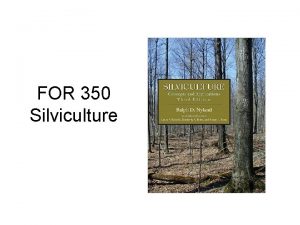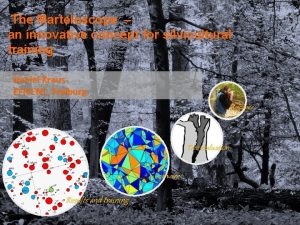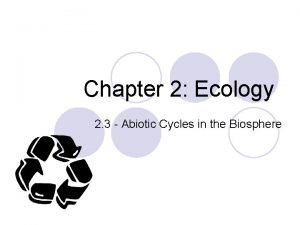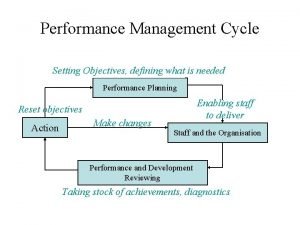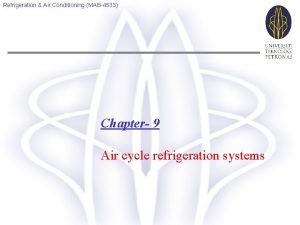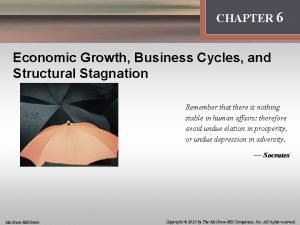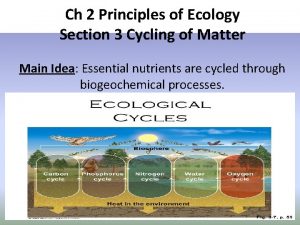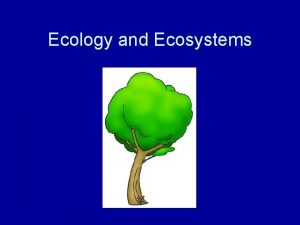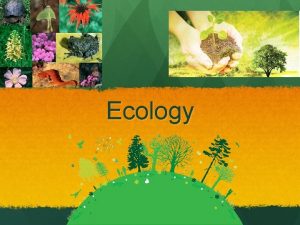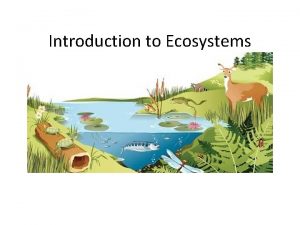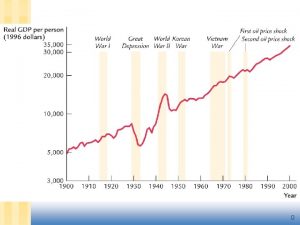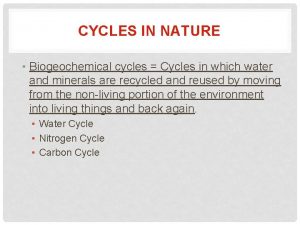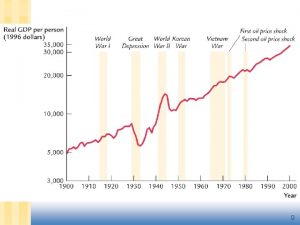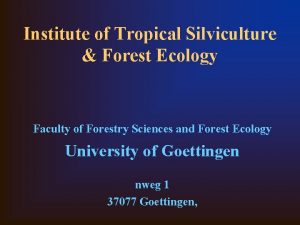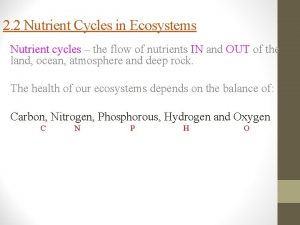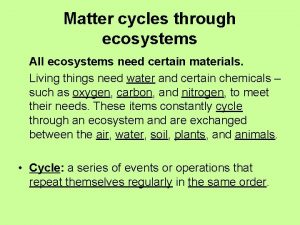7 Silviculture 5 General ad Ecosystems Ecology Cycles



























- Slides: 27

7. Silviculture 5. General ad Ecosystems Ecology Cycles 7. Silviculture a. Silvicultural Systems • • • 7. ��������� /����� Introduction & Objectives Forest Tree Species Assemblages in Natural and Plantation Forestry Natural Forests & Regeneration Patterns Coppice Forestry - Regeneration Coppice with Standards Forestry - Regeneration High Forest Age-Class Systems - Regeneration Femel- and Plenterforest Systems - Regeneration Agroforestry Systems Ecologically adapted Assemblages of Forest Tree Species b. Silvicultural Practice - Forest Tending and Harvesting • • • Introduction & Objectives Tree Characteristics, Stand Structure and Stability / Resilience Height and Diameter Increment, Shape and Value of Timber Trees Principles of Preventive Tending and Protection Early, Mid-term, Mature and Old-Growth Stand Tending, Thinning & Harvesting Systematic and Selective Wood Extraction Stand Regeneration Systems Management for Natural Regeneration Management for Planted Forests Seeding, Seedling and Sapling Planting and Underplanting Forest Restoration and Transformation between Management Systems Course: Siliviculture and Forest Protection Joachim PUHE a. ���������� • ��������� ����������� ����� • ������������ • ��������� - ���� • ��������� ������� - ����� • ������� ��������� • ���������� �� ���� • �������� • ���������� �������� b. ���������� -����� • ����������� , ��������� �� ����� /����� • ����������� , ����������� • �������� ����� • ���������� , ����� �� ������ ����� , ���������� • ��������� ������� • ����������� • ���������� • ����� , �������� ���� • Forest Restoration and Transformation between Management Systems

7. Silviculture 7. ��������� /���� a. Silvicultural Systems a. ���������� Introduction Silviculture, alike agriculture, was already identified by the Romans (Plinius) as tree- and forest related technique of cultivation. However, forest destruction of the Middle Ages forced our raw-material (i. e. wood & forest related) dependant medieval and early-industrial societies to recover the organized production of wood through forest management. Since about 1700 A. D. (e. g. Von Carlowitz 1713: Silvicultura oeconomica; Cotta, 1816) silviculture has been considered and promoted as a planned establishment and treatment of forest stands intended to achieve shortand long-term economic and ecological goals. Strongly debated and discussed since the 18 th century, the different techniques and methodologies to rebuild forests were trained and disseminated through specialised Schools of Forestry in central and western Europe (France, Germany, later in the U. S. ). Different from agricultural cropping systems, forests – due to their long-term production cycles – have mostly been recognised as natural or close to nature systems subject to environmental and biological rules and constraints, where rather ecological than economic thinking should govern. Nonetheless, from the early beginnings, two general almost contradicting perspectives and “ideologies” of forests as primarily (i) wood-producing or (ii) natural ecological systems have dominated forest education, forest management and not least the resulting forested landscapes, which often make up a third or more of the temperate zone area of the northern hemisphere. This represents still half of its original share at the onset of agriculture some 7000 years ago. i. ) the “soil-rent theory” (Bodenreinertragslehre) conducts the objective of forestry towards economic short-term goals, by striving for maximum internal rates of return (irr) or by using net present values (npv) with attractive discount rates, for achieving economic forestation investments for appropriate economic return. This leads to short -to-mid-term rotation cycles of easily manageable pure stands, frequently favouring conversion of locally adapted natural forest ecosystems into faster-growing, often foreign coniferous monoculture plantation forests. Such concepts are mainly governing large-scale private investments in plantation forestry. ii) the opposing forest school favoured the “forest-rent theory” (Waldreinertragslehre), a concept which follow long-term objectives that not only comprise wood production or industrial wood production as the only objective of forestry, but also the generation of social, welfare, protection and other environmental benefits. Such a concept stresses the stability of ecosystems and their resilience against environmental and biological risks, functions which are frequently favouring naturally established forest arrangements close to the potential natural forest vegetation mixture. This concept is often dominating in densely populated countries where the diversity of forest functions is strongly needed and taken into account, particularly in forest areas of public ownership. ����� , �������������� ����� �������� (���� ) ������������� , ������������ �������������� �������� ��������� 1700 ������ (e. g. Von Carlowitz 1713: Silvicultura oeconomica; Cotta, 1816) ������������ �������� �� ���������������� ���������� ���������������� ������������� ��������� ������� ��� -��. ���������� , ������������ ���� , ������������ , �� ����������� , ����������� ���������� , ����������� , ���������� ����� , �������� ������ , ����������� ���� , ������������� (1) ������ , ����������� ��(2) ������������ 9������ , ���������������� ���������������� ����������� 7000 ���� ���. 1) ������� (Bodenreinertragslehre) ����������� ����������� �� ��������� ���������� , �������� ����������. �� ����������� �������� ����� , ������� ������� , �������� ���������� ������������������. 2) ������� ������� “������� ” (Waldreinertragslehre), , ����������� ��������� , ������������� ������������������ �� �������� ��������� , ��������������� ��������� , ������ �������������� , �������������� �������. Course: Siliviculture and Forest Protection Joachim PUHE

7. Silviculture 7. ��������� /���� a. ������ a. Silvicultural Systems ������� Objectives Silviculture in the context of forest sciences is also considered as a discipline which synthesises and builds on the diverse basic disciplines of forest sciences, based on ecosystem knowledge and analysis, i. e. Forest Botany, - Zoology, - Geosciences, - Meteorology, - Vegetation Sciences and – Soil and Site Sciences. This is necessary in order to derive adequate decisions on forest composition and stand management in the specific growth phases of patches of trees and forest stands of different sizes. Silvicultural Management includes decisions on natural, supported and/or entirely artificial reproduction, tending, thinning and harvesting through the entire growth cycle. The term “Sustainablility” was originally developed in the central European forest management context which aimed to keep the rate of harvesting in balance with growth and regrowth of forests, at the national, forest district and even at the compartment or stand level, particularly in the more recently developed perspective of “plenter-forestry” and small-holder forestry. Sustainable Forest Management may also comprise: -Sustainability of the local ecosystem potential -Sustainability of forest production (wood & other products and benefits) -Sustainability of optimum financial return (benefits – costs) -Sustainability of the forest management unit (private enterprise, public administration) ������� “����� ” ��������� ����� , ���������� ������� �������� , ����� �� ������� /������� �� , �������� ����������� �� �. �. ”������� ” ������������� : • ������������� • ���������� (������� , ������ Exploitation forestry in contrast to thoughtful and sustainable silviculture-based forestry has resulted to large-scale devastation. In many parts of the temperate zone stable agricultural systems replaced productive lowland foothill forests. Destruction of primarily riparian and mountain forests in highly sensible areas, however, not only cause immense losses of habitat and species biodiversity, but until nowadays result in more pronounced catastrophes for human society, through floods and avalanches. However, human decision can easily “restore” such ecosystems, where suitable genes and species are available. In the humid tropical zone, however, the disappearance of natural forests is causing losses of biodiversity and of elementary components of the ecosystems, which are irreparable within the human time perspective. Course: Siliviculture and Forest Protection ������������ ����������� ����������� , ����� �������� -����������� ������������� , ������ ������������� ������ ���������������� ����� , ������������� ���� -������ ����. Joachim PUHE ����� ) ����� • ����� ���������� (����� -������ ) • ��������� (������� , �������������� ). ������������ �� �������� ������ ������������� ������������� �������� ���������� ����� ������� , ������� ����� , ������� ������������� (������ , ����� ) ������� , ����� �� ������� ������������ ������� , ��������� ���������� , ��������� �� ���������� ���� , ����� �� ���������.

7. Silviculture 7. ��������� /���� a. Silvicultural Systems a. ������ Tree Species Assemblages in Natural and Plantation Forestry (1) ��������� ����������� (1) Sustainable silviculture forestry in the temperate zone can be regarded to be in full capacity to manipulate, conduct and restore the principal long-term elements of forests, influencing main ecosystem traits like tree composition and canopy density, regeneration and others. Across the European continent, principal assemblages of forest ecosystems and their dominating indicator and secondary character species have established due to climatic constraints acting principally on a large-scale. These are modified by heterogenic conditions in mountainous environments and through sub-optimal soil conditions, which usually lead to shifting competitiveness between species present in the respective climate zone. The common set of environmental variables, has been recently modified by a drastically changing “chemical” environment in the industrial and densely populated regions of the world and will even be more changed in future due to shifts of climatic zones. This may leave only few species competitive at their present site of occurrence and will lead to completely new habitat and ecosystem assemblages. However, many parts of the southern Caucasus served as refugia and hotspot of renewal for many species of the Eurasian temperate zone during the late Tertiary and the climatically unstable Quarternary. The main environmental context for the forests as we know them today, established during some 100 -200 reproduction cycles, or during just a few dozens of old-growth forest cycles. This happened since the warmer Atlantic time of the Holocene, approx. 9000 cal. yr B. P. , almost parallel to human agricultural development (‘neolithic revolution’) and was accompanied by subsequent stabilization and improvement of climate and soil conditions due to weathering, accelerated formation of clay-minerals and humus in former glacial tundra or ice-covered areas, but also across the adjacent zones of the Mediterranean, Black Sea and South Caucasus, as well as the mountainous parts of western Eurasia. Course: Siliviculture and Forest Protection Joachim PUHE ���������� �������� ������������� , ���������� , ����������������������. ������������������������������� �������������� , ������������ �������� “����� ” ����������� ������� ������� , ����� “������� ” ���������� , ����� ��������� ����������� ������������� ������������ ������������ ���������� , ��������� ������� �������������� ������������ �������������� 200 -300 ������������ �� ��������� ������� ��������� ������� (9000 ���. �. ������ ) ���������� ������������� (��������� ) �������� ��������� , �������� ��������� ��������� ��������� ������� �� ���������� �������.

7. Silviculture 7. ��������� /���� a. Silvicultural Systems Forest Tree Species Assemblages in Natural and Plantation Forestry (2) Environmental conditions and the way in which Holocene developed have led to mainly climate-controlled patterns of tree species distribution in the local contexts of site-prevailing soil and habitat conditions. This has resulted in forest and habitat assemblages with dominating “character” tree species in bioclimatic regions such as ‘Atlantic’, ‘Subatlantic’, ‘Subcontinental’, ‘Continental’, ‘Boreal’, ’Submediterranean’, ‘Mediterranean’ in west-east and north-south direction. In addition, there exists a regionally diverse altitudinal north- and south-facing and/or luv- and lee- site mountain zonation. These bioclimatic regions are directly linked to warmth and moisture conditions, identified by parameters such as ‘growing degree days’ and ‘climatic precipitation deficit’. Among the prevailing character forest tree taxa in today’s conditions we can identify beech, oak, pine, spruce, fir, birch, larch, which constitute the dominating native tree species in the vast majority of the European and nearby forest communities. Other taxa like hornbeam, maple, ash, elm, lime, chesnut, poplar, alder and others are frequently found as part of different types of forest ecosystems, but only of local importance as dominant species. Forest management decisions in the past have led to an alteration of natural forest composition chiefly in the most densely populated and most deforested countries, due to immediate needs of wood as raw material and market- and finance- driven prioritizing of forest areas as designated to wood production. This has led to shift of species distribution in favour of mostly native (but often not locally adapted) conifers such as spruce and pine, or –often in more restricted areas of plantation forests- towards introduced species such as douglas fir, sitka spruce, eastern white pine or other conifers, oaks, robinia, eucalyptus and other broad-leaved species. Extensive afforestation with introduced species was particularly favoured in heavily deforested countries, such as Ireland the U. K. , Portugal, etc. Nonetheless, intensive forest management at the specific site, has generally promoted shifts of ecosystem and species (genetic) diversity towards value-oriented proportions of species and genotypes of the dominating and secondary forest canopy layers, often not taking into account other factors. In the context of selection of reproductive material and genetic properties, only planted forests allow to use genetically identified material. This is, however, in the practice often done by planting of genetically identical material at the cost of genetic diversity and ecological plasticity. Conversely, in natural regeneration systems it is difficult to influence the genetic properties of tree individuals. The seedling composition can still be influenced (usually at a 50%) by the selection of “standard” mother trees in species of heavy seeds like oak, chesnut, beech. Species with seeds which can only be transported by air across short distances (maple, ash, hornbeam), genetic properties of the next generation are also influenced by neighouring populations. In the case of forest tree species whose seeds are distributed by wind dispersal (anaemochorous) from neighbouring and distant tree populations of unknown genetic qualities (i. e. conifers and light weighted seeds of broad-leaved, particularly ‘pioneer’ tree species) , it is difficult to influence genetic quality of the forest regeneration. Although anthropochorous, hydrochorous, zoochorous seed dispersal may only influence a small portion of the total n° of seedlings established at a site, this may change during stand development. a. ��������� ����������� ������� (2) ��������� , ��������� ������� , �������� ���������� ��������������� ��������������� ���������� ������ , ����� “����� ”, ��������� , ��������� , �������� ������� ��������. �� ������ ���������� �� ���������� ���� , ��������� ������� �� ������������ ����������� , ���� , �������� ���������� , ������ , ������ , ������� ������ ����� ������� , �������������������� ���������� ������� ���������� , ���������� ���������� , �������� ���������� � ����� , ������� , �� ������ , �������� ����������� , ����� ���� , ������ �� ������� , ������ , ������������������������ ��� ������� , ��������� , ����� ������������� (������� ) ������� ��������������� ��������������� ������������ ������ ������� , ���������� ��������������. ����� , ���������� ����������� �������� ����������� 50% �������� ������� (���� , ������ ) ������� (������� ����� , ������ ) �������� ����������� ������ , �������� ���������� ���� �� ����������� (����������� , ����� “������� ” ������� ) �������� ���������� (anthropochorous, hydrochorous, zoochorous ) ��������� ��������� ���������� ������� �������. Course: Siliviculture and Forest Protection Joachim PUHE

7. Silviculture 7. ��������� /���� a. Silvicultural Systems a. ������ Natural Forests & Regeneration Patterns ������������ Natural forests were able to expand into most lowland great parts of highland areas after the retreat of the last glaciation in most temperate, including subboreal, subcontinental, and submediterrenean zones with exception of wetlands and areas above the treeline. Outside the strictly temperate zone which is characterised by sufficient humidity and acceptable rates of organic matter cycling, regeneration of forests frequently occurs through the action of fire, and in occasionally similar extent, by the action of pests. Fire occurs until nowadays across large areas in dry mediterranean and the boreal (conifer and in Australia, Eucalyptus) belts, causing danger to populations and considerable economic losses to forestry. In the past decade, forest area losses due to natural fires (particularly in the boreal forests, and enhanced by frequent warm periods) almost began to outpace the rate of human-caused deforestation in the tropics. In the temperate zone however, a patchwork of factors is causing decay of mature trees in natural forest areas. These also may include local ignition, e. g. due to lightning, draughts, flooding , secondary attack of funghi, insect plagues (pest outbreaks) or other environmental conditions which exceed the responsiveness of trees to environmental stress. Different from the boreal zone, such tree decay and opening-up of natural forests usually occurs at the small scale, or may even affect only individual trees. The subsequent opening of forest gaps creates conditions under which forest regeneration typical for the temperate and even tropical forest zones initiates, the so called forest succession. Avoiding much of the decay that would occur to the most valuable raw material through an optimal harvest and employing it for long-term human use, is the art forest management should employ at minimal cost and with least possible interference with natural processes and habitat. Therefore nowadays the types of silviculture which are most closely adopted to the natural forest regeneration cycles, are regarded first choice for sustainable forest management. This means forest management units for (selective) thinning, cutting, harvesting and extraction of medium to larger (e. g. several ha) sizes in the boreal forest zone, and of smaller sizes (e. g. gaps of a few tree lengths or individual tree management) in the temperate forest zone and ecologically sensible forest areas, e. g. in mountainous habitats, in the timberline zone, at forest edges, in riparian forest or forest patchworks. In times of restricted financial resources forest-management also means cautious, risk and cost/benefit conscious planning of in-situ activities of cultivation and care. Course: Siliviculture and Forest Protection Joachim PUHE ����� ������������� ��������� ���������� ������ , �. �. ���� , �������� �� ������� , ����������� ������� ���� ����� , ���������� ������������� , ��������� �� �������� �������� ������� �� ������ ����� �� ��������� (������������ ������� ). ��������� ���� ������ (������� �������� ���� ) ������������ ������ ������� , �������� ����������� �������� ������ ������ , ������� , ������������ , ���������� ������ , �������� ������������ , ���������� ����������� ���������� ����� �� ��������� ���������������� , ���������� , ��� �� �������� ����� , ������� , ���������� ��������� ������������� �������� , ����������� , ������������� ���������� , ������ ���������. �� ������� , ����� �������� , ��������������� ���������� (����� �� ) ������� �� ����� (�. �. ����� ) ��������� ��������� , ���������� , �������� ������� , �������� ��������� ������ ������� , ������������ ��������� ��������� ������.

7. Silviculture 7. ��������� /���� a. Silvicultural Systems a. ����������� - ����� Coppice Forestry - Regeneration Coppice forestry has possibly been the first widely distributed silvicultural system, and in some regions it is of importance even today. Coppice forestry is based on the regeneration of the aboveground tree shoot from the stool after growth cycles of some 7 -20 years; different from high forest systems where trees grow from seeds or seedlings. Its biological advantage is conservation of the structural root system so that the root system’s uptake capacity is immediately recovered for nurturing the new shoots, thereby conserving the pedosphere better than other forms of wood extraction. For biological and tree-health reasons, cutting is commonly done during the vegetative rest phase (winter or dry period). This type of forestry is centred on easy stump - sprouting broadleaved tree species, using lime, oak, ash, hornbeam, chesnut, hazel and other species according to the expected use of small-sized and low diameter wood. It has been employed for different arts and wood products such as poles, fences, sticks, household items, fuelwood, and others, nowadays often substituted by plastics. In some cases coppice-forestry was combined with agricultural land-use (buckwheat, potato) or animal grazing after wood harvest. In the past decades and years, the importance of coppice forestry has been increasing, e. g. due to the rising importance of biofuels and wood as carbon-neutral raw-material. In some plantation systems with fast growing species in the lower latitudes (e. g. Eucalyptus) coppicing is the first choice of forest regeneration, often used for paper-, charcoal-, firewood and other non-stemwood uses. In these circumstances coppice forestry it is often described as shortrotation forestry. There exist some specific short rotation or coppice forestry like the pruning or lopping systems which maybe used for specific purposes such as basket weaving or animal feeding of twigs and fresh shoots with buds, leaves and fruits. Course: Siliviculture and Forest Protection Joachim PUHE ����� (������� ) ������������ ������������� ��������� �������� , ���������� 7 -20 ������ , ������ �� ����������� ���������� ������������ ��������� (����� ) �������� , ����� ����� �����. �� ���������� ���������� (������ , ����� , �����. ) ������������ ������ ���������� ������ , ����� , ������ , ������ , ����������� ������������� ������������ (����� , �� �������� ) �� ���������� ����������� ����������� ����������� ����������������� ������ (���. ����������� ) ����������� ��������� , �������� , ������ ���������� ���������� ����������� ����� , ������� -������� , ����������� �� ��������.

7. Silviculture a. 7 ��������� /���� Silvicultural Systems a. ������ Coppice with Standards Forestry - Regeneration Coppice with standards forests became a common forestry system in central Europe during the Middle Ages, first documentedin the 13 th century. It combined the advantages of coppice forestry with those of the broad-leaved high forest according to the major needs at that time. Nowadays it is rather rarely occurring system, with only a few percent of forest coverage. The loosely growing coppice of the understorey which serves as fuelwood and for other uses, is combined with a loosely growing overstorey of large-sized “mast” trees whose fruits (oaks: acorns; beech: beechnut or beechmast) were traditionally used for livestock feeding, as well as for growing construction wood. According to local forest regulations, use for livestock mast and grazing, cutting cycles and cutting extent of the understorey coppice as well as the overstorey trees was managed. Open Woodland with Pasture During the pre-industrial phase of agricultural development, when no feed or fodder grass is/was specifically grown for livestock raising, forests are a preferred environment for cattle raising due to its potential of additional caloric input. Recently, forest feed becomes once again considered for producing high quality meat (e. g. ham production). Usually, forests used for animal grazing are loosing their natural regeneration capacity due to intensive feeding of seeds and seedlings, thus turning into open woodlands with little undergrowth. Major trees are kept or protected as mast trees or for stemwood production, but due to lack of canopy closure, trees aren’t urged to compete for light extending their light crowns upwards, which results in low and breadth-oriented trees and tree crowns as typically found in parklands. Pasture on hill and mountain slopes, may frequently cause erosion and forest soil destruction according to the intensity and animal species employed, constraining long-term productivity of the whole system. Since the early Middle Ages pasture became restricted in densely populated areas, and subject to fees in species or money pays, according to the type of pasture employed: “floor-pasture” (forest floor species, grasses and herbs), wood pasture (buds, fruits and leaves), “earth-pasture” (forest insects, larvae and pupa stages), among others. Specialists entered the forests to estimate the annually fluctuating acorn-crop to be expected. According to the expectations, young stock was procured and quota established for the coming feeding season. ���������� /����������������� ����� ������� ����� ���������� ������� ������� , ��� ����������� �� �������� , ������� �������������� , ����������� ������� , ���������� ������ ����� , ������� (����� , �������� ) ������������� , ��������� ������� ������� ��������� ���������. ����� �� ����������� ����������� , �������� �� ������� , ������ ���������� ������������. . ������� , ���������� �������� ����� (���. ������� ) ������� , ����� ������ , ���������� , ������������. , ������� ��������� ������� (������� ). ������� ������� ����� , ����������� �� ������������ , �������� ������ , �������� ������. ����������� �� �������� � ���������� �������� ������ , �������� ������������ ������������� ���������� ���������� �� �������������� : “�������� ” (�� �������� �� ������ ), ��������� (���� , ������ �� ������� ), “����� ” (������� , ������� ) ������� �������� ���� ������������� ����������� /�����. Course: Siliviculture and Forest Protection Joachim PUHE

7. Silviculture 7. ��������� /���� a. Silvicultural Systems a. ������ High Forest Systems - Age-Class Forestry, Regeneration with Clear-Cutting and Shelterwood Systems ����������� ������� , ��������� ������ High Forest silviculture comprises all forest systems where high growing stems and stemwood production are the principal objective of stand management. High forests may develop from all forms of regeneration, such as natural regeneration, cultivation from seeds, seedlings or saplings. Due to its lacking sprouting ability, vegetative reproduction is not a choice for conifers. When forest management in the 18 th century established wood production of large sized timber for construction, mining and other volume-demanding uses of a new forestry, establishment of mostly monoculture types of forests became more widely spread. It began to convert woodlandscapes into conifer forest landscapes. This occurred in many former domains of mixed broad-leaved temperate forest area of Europe. Planned production of even wood volumes became one of the main objectives of forestry for the landlords who looked for wood resources for their needs and those of the market, enterprises, industries, growing cities, etc. In response, age-class forestry was introduced. Forested land was divided into a number of compartments or stands, to obtain annual somewhat equal wood resources. This allowed to (i) plant or seed but also to (ii) extract through thinning at pre-mature forest ages and (iii) to harvest – which all in all means to manage – the forest area on an annual basis. After a few decades a landscape of uneven heavily overexploited woodlands turned into a patchwork of even-aged forest plantations. As conifers resulted to be the first choice, their lower suitability for firewood needs and for fruit-rich livestock pasture, wood production could expand more easily. But this was only obtained at the cost of increasing conflicts with the poor peasant population, at least until fodder production, mechanization and fertilizer use became innovative aspects of farming during the Modern Times. Age-class forests are easier to manage but due to their far-from-nature design they also generate increased susceptibilities to forest insect-, fire- and other calamities (diseases, windthrow, etc. ). Repeated thinning according specific schemes and clearcuts combined with complete reforestation of the monoculture by planting, became part of the management system, particularly for conifers. Soft transitions to new stands of the same species were introduced (e. g. strip-cutting system, fig. left). They tried to take into account the increased storm susceptibility of sensitive high timber trees with weak root systems and delicate crowns on debilitated soils. In pine stands, but particularly in broad-leaved high forests (e. g. oak, beech) regeneration systems under shelterwood (fig. right) avoid clear cutting, and introduce transition phases with selection of seed trees, stronger opening of the forest canopy after a good “mast years” to promote dense coverage of seedlings, and successive harvesting takes to 30 years and more (1/4 of the rotation age) to bring forward a new tree generation. ����� ���������� �������� , ������� ���������� �������� ���������� (��������� , ������ �� ������ , ����� ������ ����� �� ���������� �������� ������ , ��������� ������� , ������������ �������� ������ �����������. �� ������� ������� ��������� ������� ������� ����������� ���������� ������ �� ������� , ����������� ���������� ���������� (�) ����� �� ������ (�� ) ����������� ��(��� ) ����� , ������������ ������ , ������� ����������� �����������. �� ��������� ��� �������� , ������ ���������� ��� , ���������� ������ �� ���������� ������� , ����������� �� ������ , ���������� ������ , �������������� ������� ����� , ������ ����������� , ������� ������������� �������� , ����� � ��������� ������� �������� , �������������� ����������� ������������ ������� , �������� ������� (������� ). ��������������� ����� (���. ���� �� ������ ) ����� ������� (���. ���� ) ��������� ������� ���� , ���������� ����� ������ , ������� -��������������� ����� 30 ������ (����� ¼), ������ �������. Course: Siliviculture and Forest Protection Joachim PUHE

7. Silviculture 7. ��������� /���� a. Silvicultural Systems a. ������ High Forest Systems - Femel- and Plenter- Regeneration Femel regeneration systems represent a type of transition between regeneration under shelterwood and close-to nature individual culling (Plenter) regeneration of forest stands in the temperate zone. Femel and Plenterwood systems have particularly developed in the undulated and mountain landscapes of forest smallholder tenancy. There, a steady provision of small amounts of wood for different uses and of different sizes and quality was the main objective, and little attention was paid to operational time and costs, as few operational and transport alternatives exist for the individual owner. Femel regeneration is initiated with the opening of the forest canopy and generation of group wise gaps (of a few stem lengths) in the high forest to be harvested. Within the gap and its transition zones into the surrounding forest, different conditions of light and microclimate allow for a diverse set of regeneration conditions. By distributing gaps across the forest stand their successive widening in shorter steps of a few years, the goal of an uneven-aged and species-diverse stand is attained after several decades. Under specific circumstances, e. g. a densely closed forest canopy of the previous stand, a previous thinning (to less than 0. 7 stocking density) which results in a loose type of “shelterwood”, the intended future species and genetic composition can be approached in the mother trees. In Plenterwood (individual “culling” ) silvicultural systems, harvesting and regeneration is oriented at the single maturing tree, and silvicultural activity mostly consists in selecting and harvesting of mature individuals at their stage of optimum value or benefit. In the forestry practice, Plenter-silviculture is often extended or mixed-up with practices of Femelsilviculture, in order to optimize costs or to achieve a proper composition of the young stand. ����� ������� ���������� ������ ������ ��������������������� ������������� ������ �������������� ���������� ������� ����������� ���������� �������������� , ������������� ������� ������������� ���������������������. ���������� (������� ) ���� �� ������������ ��������� , ��������������� ������ ���������� , ���������������������� ������. Course: Siliviculture and Forest Protection Joachim PUHE

7. Silviculture 7. ��������� /���� a. Silvicultural Systems a. ������ Agroforestry Systems �������� Due to an increasing population and shortage of agricultural land, forests on the most productive soils turned into areas of human settlement and agricultural use. This happened in the Middle Ages in the European temperate zone, where still traces of different forest-agricultural systems can be noticed within today’sforests, often given-up after the “black death” killed large portions of the human populations and many settlements, particularly forest settlements, were abandoned. Agroforestry systems were part of many temporal agricultural practices (e. g. shifting cultivation) in some tropical and subtropical forest biomes, where human hunter and gatherer cultures also introduced agricultural practises. Where nowadays in the humid forest zone of the lower latitudes new settlements are founded without a complete conversion of forests into farmlands or pasture, agroforestry systems may form part of agricultural land management. Definition: Agroforestry is a collective name for land-use systems in which woody perennials are grown in association with herbaceous plants [agrosylvicultural] and/or livestock [sylvopastoral] in a spatial arragement, or rotation or both, and in which there are both ecological and economic interactions between the tree and non-tree components of the system (A. Young, 1989). The term agroforestry system is applicable when at least a minimum shelter of tree canopy (e. g. 10% canopy density) is conserved or introduced as overstorey of the agricultural management systems. Among crop farming systems which need or can employ agroforestry practices for optimum results we can find as main agricultural crops those which originally developed inside forests of different shade regimes, i. e. cacao (Theobroma cacao: dense forest), coffee (Coffea arabica: open forest - shrubland). Agrosilvicultural systems are mostly used in smallholder farming systems. They are similar to a multistorey gardening system, where diverse shade-sunlight and humidity regimes, supported by an intensive management and cycling of organic matter, allow optimum growth conditions for a high variety of locally adopted crops (herbs, tubers, fruit trees and shrubs). By contrast, silvopastoral systems use trees as protective, humidity, shade, fodder or nutrientgenerating (e. g. leguminous trees) element in rangelands or pastures used for livestock raising. ��������� ������������ , ����������� ���������� �����������. �� ��� ������ ����� , ����������� ���������� , ���������� “����� “ ����������� ������� ������������ (�. �. ��������� ) �������� �������� , ����������� “������� ” ���������� ����������������� , ������� ������������. ����� : ������� ���������� , �������� ����� ������������ (agrosylvicultural) �� /�� ���������� , �� ����������� ���������� , ����������� ������������ ( A. Young, 1989). ����������� �� ���� , ������� ������� 10% ���������������������� ����� , ������������ , ���. : ����� ( ������� ), ���� (��� ��������� ). ��������� ���������� �������������� , �������������� -���������� �������� ������������ ������������������� (�������� , ������� ). ��������� , ��������� ������� ������ , �������������� ������� �� ����� , ����������� ����. References: Young, A. (1989) Agroforestry for Soil Conservation, CAB Intl, 276 pp

7. Silviculture 7. ��������� /���� a. Silvicultural Systems a. ������ Ecologically adapted Assemblages of Forest Tree Species ����������� �������� As one of the principal centers of Quaternary glacial refugia, the Caucasus region is home of a variety of diverse broad-leaved taxa and species, well adapted to present local and potentially changing future environmental conditions. Under these circumstances, well-managed local assemblages from natural regeneration can form a good basis for the production of wood and environmental services according to consented priorities and human needs for timber and non-timber products. The extension of local silviculture towards the use of introduced forest species is an option, as long as it doesn’t interfere with the consented and established circunferences of areas of native biodiversity. The use of foreign tree species may be appropriate in near-urban areas of steady human interference or in areas of new afforestation of formerly non-forested lands, e. g. rangeland afforestations. In considering the natural range, short-term and long-term competitiveness of forest tree species, and their position in the successional advancement of a forest, the task of silvicultural management should focus on choosing and promoting the optimum species assemblages and individuals during stand development. In this context, potentials and tolerances of each species should be considered as guidelines for an optimum species composition of the growing and maturing forest. The species’ climatic potential and breadth, its maximum and preferred soil moisture regime as well as its soil acidity regime and base saturation requirements are the main criteria for its horizontal and vertical distribution in a growth region. At the stand level, stand history, management and competitiveness are of importance for the species occurrence and prevalence. There are but additional factors which influence the likeliness of acquiring maturity and being represented in the mature forest stand, including: (i) regeneration potential, height growth, life duration, root growth (ii) light and shade tolerance, aridity tolerance, waterlogging tolerance, cold tolerance, early and late-frost resistance, nutrient deficiency tolerance (iii) wind-throw and snow-breakage resistance, forest-fire resistance, resistance against biotic damages Principal forest tree taxa in the Caucasus Region: Broad-leaved (angiosperms): Fagus, Quercus, Carpinus, Castanea, Acer, Fraxinus, Tilia, Ulmus/Zelkova, Juglans, Sorbus, Pyrus, Malus, Prunus, Ilex, Ficus, Staphylea, Diospyros, Ostrya, Pterocarya Betula, Alnus, Populus, Corylus & others Conifers (gymnosperms): Abies, Picea, Pinus, Taxus �������� ��������� : �������� (angiosperms): Fagus, Quercus, Carpinus, Castanea, Acer, Fraxinus, Tilia, Ulmus/Zelkova, Juglans, Sorbus, Pyrus, Malus, Prunus, Ilex, Ficus, Staphylea, Diospyros, Ostrya, Pterocarya Betula, Alnus, Populus, Corylus & others References: Puhe and Ulrich (2001), Röhrig and Ulrich (1992), Ellenbers (1988), Mayer (1977) Course: Siliviculture and Forest Protection ������� , ��������� ����������� , ��������������� ��������� ������� ���������� , ������ ���������� ������� �� ��������� ��������������������� ����� , ����� ���������������� ����������� ���������� , �. �. ���������� ���������� ������ , �������� ���������� �� ������ �������� , ������������� ������� ��������������� , ��������� (������ ), ���������� ������������ �� ���������������� ������� , ������ �� ������������������������ , ������������ ��������� , ������� : (i) ���������� , ������������ , �������� ; (ii) ��������� , ���������� , �������� , ���������� (iii) �������� ������ , ������������ ������ (gymnosperms): Joachim PUHE Abies, Picea, Pinus, Taxus

7. Silviculture 5. General and Ecosystems Ecology Cycles 7. Silviculture a. Silvicultural Systems • • • 7. ��������� /����� a. ���������� Introduction & Objectives Forest Tree Species Assemblages in Natural and Plantation Forestry Natural Forests & Regeneration Patterns Coppice Forestry - Regeneration Coppice with Standards Forestry - Regeneration High Forest Age-Class Systems - Regeneration Femel- and Plenterforest Systems - Regeneration Agroforestry Systems Ecologically adapted Assemblages of Forest Tree Species • ��������� �������� b. Silvicultural Practice - Forest Tending and Harvesting • • Introduction & Objectives Tree Characteristics, Stand Structure and Stability Height and Diameter Increment, Shape and Value of Timber Trees Principles of Preventive Tending and Protection Early & Mid-term Tending and Thinning Mature and Old-Growth Stand Tending, Thinning & Harvesting Illustrative Sheets - Stand Regeneration Systems – Strip/Border, Shelterwood, Femel (group-) & Plenter (individual cutting) - Forest Plantation Operations (Planning, Site Preparation, Planting, Tending, Harvesting & Extraction) - Thinning and Harvesting Practice - Seeding, Seedling and Sapling Planting and Underplanting, Traditional & combined Systems Forest Restoration and Transformation between Management Systems Course: Silviculture and Forest Protection Joachim PUHE ����������� • ������������ • ����������� ������� • ��������� ������� - ����� • ������������ -����� • ���������� ����� • ��������� ����������� b. ����� ����� • ����������� , ��������� /���� • ����������� , ����� ������ • �������� ����� • �������������� ����� , ���������� • ��������� ������� • ����������� • ���������� • ����� , �������� ���� , �������������

7. Silviculture 7. ��������� /���� b. ���������� -����� b. Silvicultural Practice - Forest Tending and Harvesting Introduction and Objectives (1) ��������� (1) Forest Care and Tending should contribute to a maximum production of benefit obtained form the forest unit. Depending if these benefits are considered to be of purely economic or non-ecomomic character or of combined nature, forest care may be oriented at the ecosystem as a whole or, conversely, at production of timber value (or volume). In most of the cases however, silviculture will aim at producing a combination of environmental or monetary benefits, or is forced to act cost-neutral. Thus, planning and management work in the office, as well as investment and maintenance of forest infrastructures and in situ silvicultural activity, will be under pressure to minimise costs and permit balancing overall expenditures with earnings of the forest enterprise or administration. In consequence, promoting and fostering the value of forests and their standing volume at a minimum of costs, is an important objective of silvicultural management. SILVICULTURAL CARE AND TENDING means: during forest regeneration and establishing the young stand: (i) sowing, planting or opening the overstorey by (selective) cutting of mature trees to promote regeneration, which may include other measures during tree maturation in mixed, mid-aged and mature forests: (ii) thinning, i. e. cutting of selected individuals, rows or groups of trees during the different growth phases towards maturity (‘young growth’, ‘thicket stage’, ‘pole stage’, ‘timber stage’) in order to further the advancement of the proposed mixture of tree species and/or individual (e. g. well shaped) “elite stems” of highest value potential Course: Silviculture and Forest Protection Joachim PUHE ������ ������������������ , ������ ������ , �� ����� , ����� ������ ����� , �� ������� , ������������ ��������� , ��������� , �������� ������� �� ��������� ������ , ����������� ����������� ������ , ���������� ������������ ������� ��������� ������� : ���������� ������� : (i) ����� , ������ ������ (���� ) ������ /������������ ���������� , ��������� ���������� : : (ii) ����� �������� �� �������� (������ , ���������� ), ���������������� �� ���������� ������.

7. Silviculture 7. ��������� /���� b. Silvicultural Practice - Forest Tending and Harvesting b. ���������� -���� �� ��� Introduction and Objectives (2) ��������� (2) SILVICULTURAL MEASURES in young or pre-mature forest stands - (i) in plantation forests of low species diversity, management will tend to bring the stand to maturity, maximising the wood quality and merchandisable volume which can be produced and minimizing the risks of pre-mature damages of collapse of the system. - (ii) in mixed forests of native species composition, the silvicultural goal will be to increase value (e. g. timber value) and ongoing production of other prioritised benefits (e. g. production of species and fruits , firewood; protection functions; biodiversity and habitat functions). This means implementing adequate thinning measures to promote high-value fine wood portion of the stand, maintaining or increasing other expected benefits. SILVICULTURAL PLANNING in forest stands ready for harvest - these include e. g. (i) mature or over-mature stands as well as (ii) pre-mature stands at risk or (iii) cleared or unforested sites designated forestation - Before a new rotation cycle is initiated, silvicultural planning will have to define target tree species composition and regeneration system to build up the next tree generation & forest ecosystem. Planning will have to take into account the ecological -fitness, -requirements and – potential of the target tree species. This includes their likely performance during different successional stages, as well as ecological flexibitity and capacity to adapt, e. g. to future environmental & climatic change. ������������ ����� - (i) ����������� ����� , ���������� ����� ����������� , �������� ��������� ���� �� ������. - (ii) �������������� ������� ����� (���. ���� ) ������ �� ����������� (���. �������� , ��������� , ��������� ) ������. �� �������������� ������� �����������. ���������� ��������� : - �� ������� ���. (i) ����� �� ������ , ������� (ii) �������� ���� (iii) ����� �� �������� , �����������. -����� ����� , ������������� ������������ ������� ���������������� ������������ ��-�����. �� ��������� ������������ , ��������������� ��������. Course: Silviculture and Forest Protection Joachim PUHE

7. Silviculture 7. ��������� /���� b. ���������� -���� �� ��� b. Silvicultural Practice - Forest Tending and Harvesting Tree Characteristics, Stand Structure and Stability (1) Trees give origin for the environmentally friendly and renewable natural resource of wood, twigs, leaves, bark, fruits and other raw material and services. Forest and silvicultural management has so far concentrated its attention on producing COMMERCIAL TIMBER, e. g. merchandisable wood with diameter above 5, 7 or 10 cm. As the highest value form of wood is straight formed roundwood with little taper, torsion or dead branches, it is this ideal of well-shaped trees that forest management is trying to select during stand development. Frequently, about half of utilizable timber volume is extracted during different stages of pre-mature thinnings. Thus, the final overstorey of e. g. between 50 (oak) – 200 (spruce) trees per ha may only represent 50% of the stemwood volume, although some 90% of wood value, produced during its entire cycle of 50 (poplar) – 200 (oak) years. Stand structure and stability, particularly in even-aged forests, often require a 2 -or 3 -storeyed vertical structure. This allows to keep wind damage low, to improve branchlessness of the elite trees, and to improve light conditions and habitat characteristics, which are also of importance for nutrient, element cycling, decomposition of dead organic matter and the health state of the ground vegetation and soil biota. Vertically structured crown layers can be attained by maintaining slowly growing tree individuals in the understorey or fostering less competitive, often shade tolerant, admixture (subsidiary or ancillary) species in the second or third storey of the crown layer. A vertically structured crown layer also allows to maintain high-valued tree species surrounded by subsidiary trees, even if they are less competitive as the main or dominant tree species. Course: Silviculture and Forest Protection Joachim PUHE ����������� , ��������� �� ����� /������ (1) �������������� ��������� , ������� , ������� , ������ ��������� ����� ���������� , �. �. ������� 5, 7 �� 10 �� ��������� ���������� �������� ���� , ������ ���������� ������ ��������� ������� , �������� ���� ���. 50(���� ) - 200(����� ), �������� 50% ������ , ����� �� ������� 90% ������� , ����� �������� ������ , ������ 50 ���� �� ����� 200 ��������� , ������� ������� , �������� ��� ���������� ����� , ����������� ������� ������������� , ������� ��������� , ��������� ����������� ���������� ������ ������� ��������� , ������������� , ���������� �������� ����������� ����� �������� ����� , ����� ������������ ���������.

7. Silviculture 7. . ��������� /������� b. Silvicultural Practice - Forest Tending and Harvesting b. ���������� -���� �� ��� Tree Characteristics, Stand Structure and Stability (2) ����������� , �������� /������ (2) Competition for water and nutrients through root growth, and competition for light through crown development, decide about the composition of species and individuals in a forest stand its subunits during the different developmental / successional phases. As a tree is outcompeted by its neighbours, its light-crown gets suppressed and finally fades due to restriction of light, which is needed for photosynthesis and production of carbohydrates for continued plant growth and survival. If forest management doesn’t interrupt the natural cycle of growth competition and death through systematic or selective thinning and harvest, no raw material such as wood will be extracted for human use, and the outcompeted stems will successively die, fall apart and be decomposed by a food web of detritivorous animals and organisms (fungi and bacteria, nematodes, insects, woodpecker, etc. ). “Clean” forestry practices try to avoid or eliminate dead tree material, in order to minimise spread of damage to healthy trees, reducing risk of fire through accumulation of dead dry matter or impeding mass outbreaks (gradations) of insects which feed on both dead and susceptible live material. Clean Forestry is mostly a claim for planted or natural (boreal, high mountain) forests of little tree species diversity. “Nature-oriented” forestry practices try to promote habitat quality by also allowing dead material, but swiftly attending potential nuclei of pest outbreaks through specific mechanic or biologic measures (e. g. through debarking of infested trees; employment of pheromone traps, etc. ). Course: Silviculture and Forest Protection Joachim PUHE ��������� �������� ����� ����������� ������������ ������������� �������� /���������� ������������ , �������� , ����������������� �� ��������� , �������� �� �������� ����� ��������� �� ��������� , �������� ������� , �������� , ����������� ��������������� �� ������ (������� , ���� ���. �. ). “����� ” ������� �������� , ������� ����������� ��������� ����� �� ��������� ���������� �� ���������� �������� , ����������� ������������� �������� �������� ��������� ���������� ����������� ������ (���. �������� , ������ �����. )

7. Silviculture 7. ��������� /���� b. Silvicultural Practice - Forest Tending and Harvesting b. ���������� -���� �� ��� Height, Diameter & Volume Increment, Shape and Value of Timber Trees (1) ������� , ���� �� �������� , ������� ������ (1) HEIGHT INCREMENT is an important feature of tree and forest growth. It decides about competitiveness of the individual tree and is driven by plant, soil and the climatic conditions of the current year. Among different species, it may be different at different tree ages and in the different stages (early-middle-late) of forest succession. Height increment i. e. shoot elongation, also shows seasonal patterns, e. g. pine showing early start of shoot elongation, and oak still performing height increments in mid summer. Coppice shoots (stump sprouts) show an early fast height increment, but are surpassed after some years by trees from seedling origin, when these have established their root systems. Height increment is also physiologically important for the tree in order to produce new leaves within the upper light-exposed crown, as these are much more efficient in producing carbohydrates than “shade” leaves in the lower crown. ����������� �������������. �� ������������ , ��������� , ����������� ��������� ����� �� ������ (������� -������ ). ����� , �������� , ��������� ������� , ������� ���������� ����� , ����������� ���������� , ��� �������� ������� ��������� , ������ ������� , ���� �� ��������� ������ , ����������. Height increment (cm/year) often culminates during the young stage of a tree, mostly at ¼ of its maximum productive age. Light-demanding and “pioneer-type” species have commonly stronger increments during the early stages of growth, meanwhile shade-tolerant late successional tree species show later culmination of their height increments, establishing their competitiveness often during the second half of their productive age. Course: Silviculture and Forest Protection Joachim PUHE ������ (�� /���� ) ����������� , �������������� ¼ ��������� ��“������ ” ��������� ������ �������� , ������� ��������� ��������� ������ , �������������.

7. Silviculture 7. ��������� /���� b. Silvicultural Practice - Forest Tending and Harvesting b. ���������� -���� �� ��� Height, Diameter & Volume Increment, Shape and Value of Timber Trees (2) ������� , ���� �� �������� , ������� ������ (2) It is noteworthy that both, predominating and strongly suppressed individuals, are not likely to change their competitive category during stand development, but more than half of the intermediate dominating, co-dominating and dominated individuals may change their competitive position (mostly downwards) , during early or midlife stand development. ������ , ��������� ���������� ������������� ������������ , ��������� ��������� ������������ , ������ ������������ �� ��������. As mostly late-successional tree species are the target objects of silvicultural management, young growth, thicket and pole stage management is focused on maintaining and facilitating competitiveness of the future elite trees, avoiding their suppression by earlysuccessional competitors. This, however, has to be realised at the lowest possible operational cost. During the first half of stand development silvicultural tending mostly reacts on height increment, as its main purpose is modifying natural competition between individuals. DIAMETER INCREMENT patterns are similar to height increment, only occurring slightly behind the latter, as they reflect storage of excess carbohydrates not consumed for tree growth and maintenance. Although height increments slow down to a minimum after approx. ¾ of productive tree age (target age), diameter increment is likely to continue, so that VOLUME INCREMENT continue at high levels. In freely growing stands or tree individuals, target ages are often reached when the ongoing annual volume or value increment does no longer exceed the mean increments over the entire life span obtained by that stand or individual Economic paradigms that part from a view of financial return –by calculating forest value and its economic benefits- solely focus on the revenue from timber sales. Here, rather the opportunity costs, interest rates and “financial maturity” of timber trees matter as forest yield is compared with economic output from alternative uses of land. This view of natural resources, related to the “soil-rentability-theory” (Bodenreinertragslehre) imply short rotation cycles. Course: Silviculture and Forest Protection ���������� ������� ������������ ���� (����� , ������� ) ���������� ������������� ������ �������� ����� �������� ������������ �������� ������� , ���� ��������� �������� , ������ , ���������� ������������� �� �������� ��������� ���������� ¾ ���� (������� ), �������� ����� ������������. ��������� �� ������� ����� , ��������� ����������� ������������ , ��������������� ������� , ������������ ������� �������� ����������� ������ “������� -������� ” ������� ������. Joachim PUHE �����

7. Silviculture 7. ��������� /���� b. ���������� -���� �� ��� b. Silvicultural Practice - Forest Tending and Harvesting Height, Diameter & Volume Increment, Shape and Value of Timber Trees (3) VOLUME INCREMENT, as combining height and diameter increment, is however the main object related to forest growth and wood production. In forest stands which grow under approximate canopy closure (stem density eg. around 0. 8 -1. 1 [80 -110%]; branches of the overstorey trees touch or almost reach their neighbours), incoming sunlight is used at a maximum for tree growth and excesses are completely converted into wood increments. ������� , ����������� , ����� ������ (3) Thus, silvicultural practices like thinning almost have no influence on wood increment at the stand level. But its main objective is to benefit (by competitive “interference”) the highest value “elite” tress and concentrate so much stand increment as possible on these elite trees. ����� , ������������ , ������� ������� ����������� , ��������� ���������� (���������� 0, 8 -1, 1 (80 -110%) ������� ������� ), ������������ ��������� ����������. But not always a low number of trees of large diameter and therefore high annual diameter increment, is first choice. For some applications, dense tree rings and/or high wood densities or other physical properties can be priority for high-value wood production (e. g. spruce, maple for violin, guitars). This, for instance can be achieved by maintaining higher stem density per ha, or concentrating production of such stemwood in slower growing climatic zones (e. g. at higher elevation). ������ , ���������� , ������� ��������� ������� ������� “������ ” ������� �������� ����. Course: Silviculture and Forest Protection Joachim PUHE ��������� �� ��� , ����� �������� ������ ������� , �� ������� �� �������� �������������� ������� (���. ����� , ������������ �� ����� ). ������� �������� ���� , �� ����������� ����� (���. ��������� ).

7. Silviculture 7. ��������� /���� b. ���������� -���� �� ��� b. Forest Tending and Harvesting Systems Principles of Preventive Tending and Protection In order to obtain target mixture, structure, promote development of individual trees and prevent calamities (pests, fire, physical damage) in even aged stands, subdivisions of stands or even smaller forest blocks, forest tending should initiate at an early phase of stand development. Selective action promoting development of potential elite trees (e. g. at a distance of a few meters -e. g. 5 -7 -10 m- between each other) is the first choice in natural regenerated stands where often dozens of seedlings per m 2 develop. In the case of planted forests, however, protective care and protection against pests, diseases, animal or other damage of the planted individuals (e. g. a few thousand / ha) will be the main worry of silvicultural care during the first years and decades of tree development. Economic return which is able to cover tending costs, will be possible as early as larger volumes of smaller commercial timberwood (e. g. above 15 -20 cm dbh; volumes above 50 -100 m 3 per ha) can be harvested and extracted from a site for timber transport at reasonable costs. This, however, is rarely the case during the first half of stand development or the rotation cycle, so that cost-benefit effective tending &thinning operation is one of the main concerns of today’s silvicultural management. Participation of local communitarian beneficiaries, e. g. for firewood extraction, is one alternative. In this case, operational costs for the forest owner or forest administration are limited to planning/marking and supervision and can be kept at a minimum. Course: Silviculture and Forest Protection Joachim PUHE ������� ��������� , �������� ������ , �������������� ������� ( ������ , �������� ) ��������� , ��������� �� ������� , ������������ ����������� ������ (��� ����� 5, 7, 10 �)������� ���������� , �������� -���� 1 ������������ ������������ �� ���� -�������� ��������� �������� �� ������� , ����������� , ����������� , ������ ������������ (���. 15 -20 �� ��������� 50 -100 ��� -�� ) ��������������� ����������� ������ , �������������� ������� �������������� , ����������� ������� ������� ��������� , ��������� �� ��������������� �����.

7. Silviculture b. Silvicultural Practice - Forest Tending and Harvesting Early & Mid-term Tending and Thinning EARLY TENDING of young-growth stands or forested plots is intended to prevent damage, promote and select target species and trees and to exclude dominating undesired trees, bushes or shrubs (e. g. vines, Rubus) that might cause undesired promotion of pests or diseases (e. g. fungi) or otherwise affect future development of the target population. It is supposed to facilitate an unrestricted development of the target species or individuals. Tending of young growth is frequently carried out mechanically or chemically by hand or motorized equipment; it also includes restoration of failed plants or areas without regeneration. In shelterwood or similar regeneration systems, once the young growth is established, residual trees of the overstorey (previous tree generation) can be harvested and removed. MID-TERM TENDING is initiated at the time of canopy closure of the young stand or when this is developing into an early pole stage of dbh above 7 (510) cm and mean heights of the dominant trees of some 2 -10 m. This stage is often recognized as thicket stage, as crown closure advances at high stem densities, until natural or man-driven reduction of the surviving numbers of trees is reducing stand density from some 100. 000 individuals/ha (10/m 2) to 2 -15. 000 individuals/ha or less (0. 2 -1. 5 / m 2). Mid-term tending is oriented at retaining damaged or sick individuals for reasons of forest protection and to regulate the general species mixture and structure (multi-storeyed) towards the target. Potential elite trees are identified and promoted, as well as supporting or admixture individuals of promising properties. This applies for the young stand ad well as for pole stage stands. As compared to plantations raised from planted trees, forest tending measures of young stands from natural regeneration can be more cost efficient, if properly and effectively implemented. 7. ��������� /���� b. ���������� -���� �� ��� • ������� ����� ��������� ������ �������� , ������������� ������ , ��������� (���. ������� ) ����� , �������� ������������ �� ����������� ���������� ����� �� ������� ����� �� ����������� �� ����� ������� �� ������ ����� , ��� ���������� , ����� ������� (������ ) ������� �� ����� ������������ ������� ������ , ��������� 7 �� -�� ����� (5 -10 �� ), �������� ������ 2 -10 �����. �� ��������� ���������� ������ ���� , ��������� �� ���������� �� ������� ��������� ����� 100. 000 ����� �� -�� 2 -15 ���������� �� ���� 2 ���� (0. 2 -1. 5 / m ). ������������ �� ������ ������ �� ������������� (������� )������ �������� ������� , ��������� ���������� �������������. ��������� ����� , ���������� ������ Figures (left): early tending (extraction) of predominant youg growth ( right): easing of competitive conditions of best formed young ������� �������� , trees ����������. Course: Silviculture and Forest Protection Joachim PUHE ����

7. Silviculture b. Silvicultural Practice - Forest Tending and Harvesting Mature and Old-Growth Stand Tending, Thinning & Harvesting THINNING OF (EARLY-)MATURE STANDS initiates with systematic (e. g. selection of rows) or individual selection and extraction of timber producing trees. This is the stage when the stand/tree may have reached half of its target age and diameter. Apart from ongoing criteria of wood quality, branchlessness, stem shape, etc. There are other important features to take into account. At this stage when trees have attained considerable heights, it will be important to prepare the remaining mature individuals for adequate stability and resistance, e. g. against environmental impacts and stresses (e. g. wind damage). Adequate anchorage of the root system and stability of the tree canopy can be attained by allowing the development of stable tree crowns, e. g. targeting 1/3 - ½ of tree length as a green crown, counted from the lowest living branch upwards. Figures: “A” elite trees & Thinning systems of different intensity i) pre-harvest opeming “accretion felling” ii) medium iii) strong “thinning from above” b. ���������� -���� �� ����� ��������� ���������� ������ (���. ������� )�� ������� �� ����� , ������� /�� ���������� ������� ������� ������������� ������ , ������� ������� , �������� �� ������� , ������������ �������� ������ ������ , ����������� ������ , ������� ��������� �� ��������� , ������� ������� �� ���������� 20% �� ����. THINNING OF MATURE STANDS of mid-high diameter sawtimber dimension may involve the application of specific criteria and thinning schemes, such as determination of final elite trees, selection of tree classes and tree individuals for thinning (extraction), intensity of thinning and others. The preferred extraction of the rather (co)dominant or dominated tree classes is considered crucial for both harvesting economics and future stand stability. Thinnings during the second half and last quarter of target life may involve the extraction of e. g. 20% or more of the total number of trees or volume. FINAL HARVEST, according to the type of regeneration and silvicultural system chosen, may involve only one final harvest or several steps of successive harvest for allowing undergrowth to develop and form a new tree generation. Figures (left): different tree classes of pre-dominant, co-dominant- dominated, suppressed trees; (middle): economically and ecologically unefficient “thinning from below” system; cost, stability and growth effective “thinning from above” system Course: Silviculture and Forest Protection 7. ��������� /���� Joachim PUHE ������� , ������������� , �������� �� ������ , �������� ����� �������.

7. Silviculture 7. ��������� /���� b. Silvicultural Practice - Forest Tending and Harvesting – Illustrative Sheets Stand Regeneration Systems – Strip/Border, Shelterwood, Femel (group-) & Plenter (individual selection) Course: Silviculture and Forest Protection Joachim PUHE b. ���������� -������ ��������� �������� , ����� , ���� �� �������

7. Silviculture 7. ��������� /���� b. Silvicultural Practice - Forest Tending and Harvesting – Illustrative Sheets b. ���������� -������ ������ ����� : ���� , ��������� , ���������� Forest Plantation Operations: Planning, Site Preparation, Planting, Tending, Harvesting & Extraction Course: Silviculture and Forest Protection Joachim PUHE

7. Silviculture 7. ��������� /���� b. Silvicultural Practice - Forest Tending and Harvesting – Illustrative Sheets b. ���������� -������ ������ ����� Thinning & Harvesting Practice Course: Silviculture and Forest Protection Joachim PUHE

7. Silviculture 7. ��������� /���� b. Silvicultural Practice - Forest Tending and Harvesting – Illustrative Sheets Seeding, Seedling and Sapling Planting and Underplanting Traditional & Combined Systems Course: Silviculture and Forest Protection Joachim PUHE b. ���������� -������ ������ , ��������
 Nutrient cycles in marine ecosystems
Nutrient cycles in marine ecosystems Phosphorus cycle pearson education
Phosphorus cycle pearson education Chapter 55 ecosystems and restoration ecology
Chapter 55 ecosystems and restoration ecology What is tending operations
What is tending operations What is silviculture?
What is silviculture? Marteloscope definition
Marteloscope definition Precession milankovitch cycles
Precession milankovitch cycles Multiplication of cycles
Multiplication of cycles Abiotic cycles
Abiotic cycles Management performance cycle
Management performance cycle Plasmogamy
Plasmogamy Icao doc 9966
Icao doc 9966 Air cycle cooling system
Air cycle cooling system Biogeochemical cycles apes
Biogeochemical cycles apes Biogeochemical cycles
Biogeochemical cycles How to calculate real gdp per capita
How to calculate real gdp per capita Biogeochemical cycles performance task
Biogeochemical cycles performance task 4 major biogeochemical cycles
4 major biogeochemical cycles Chapter 13: meiosis and sexual life cycles
Chapter 13: meiosis and sexual life cycles Biogeochemical cycles poster project examples
Biogeochemical cycles poster project examples Alliteration words for cycle
Alliteration words for cycle Lesson 2 cycles of matter answer key
Lesson 2 cycles of matter answer key Joke cycles
Joke cycles Nutrient cycle in ecosystem
Nutrient cycle in ecosystem 3-3 cycles of matter
3-3 cycles of matter Tsw cycles
Tsw cycles Rvguev suicide
Rvguev suicide Cycles per instruction
Cycles per instruction




